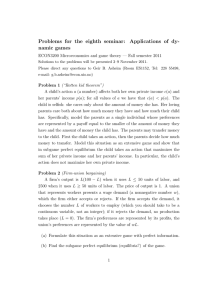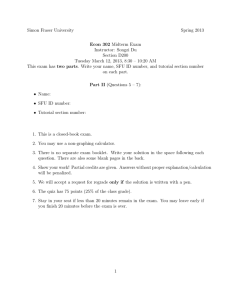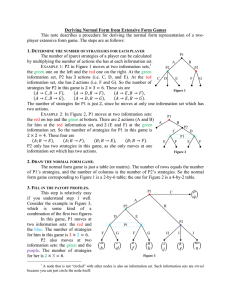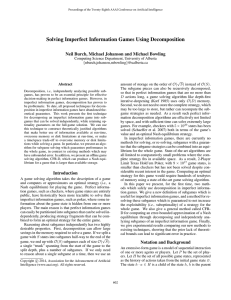6.254 Game Theory with Engr App Problem Set 4 Dictator
advertisement
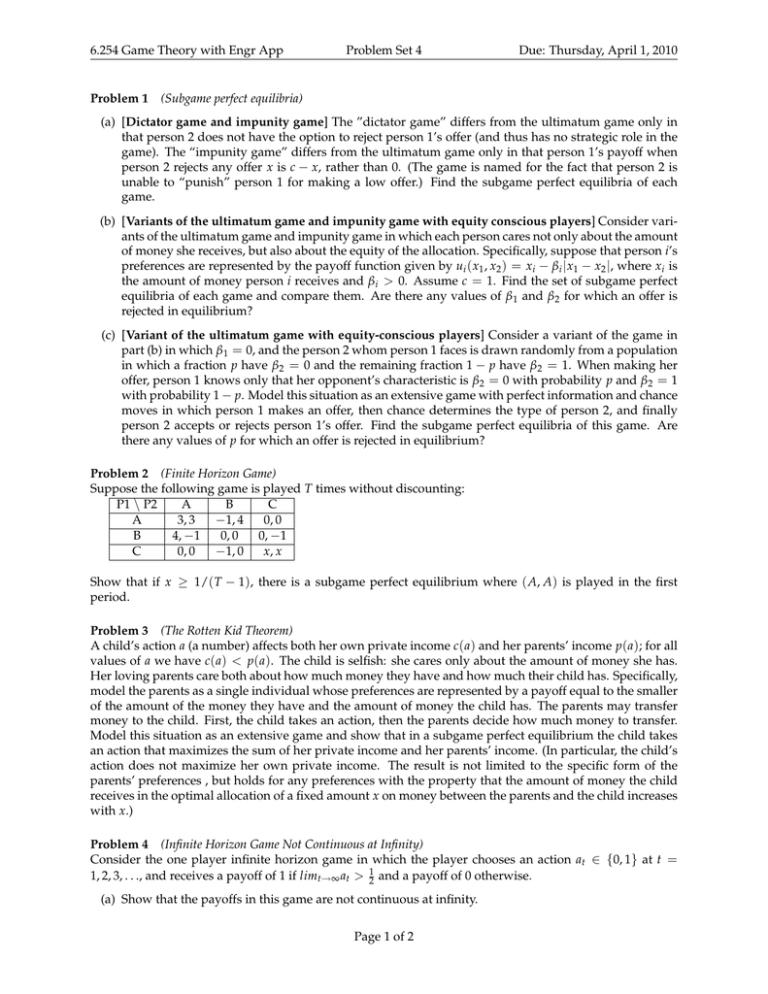
6.254 Game Theory with Engr App
Problem Set 4
Due: Thursday, April 1, 2010
Problem 1 (Subgame perfect equilibria)
(a) [Dictator game and impunity game] The ”dictator game” differs from the ultimatum game only in
that person 2 does not have the option to reject person 1’s offer (and thus has no strategic role in the
game). The “impunity game” differs from the ultimatum game only in that person 1’s payoff when
person 2 rejects any offer x is c − x, rather than 0. (The game is named for the fact that person 2 is
unable to “punish” person 1 for making a low offer.) Find the subgame perfect equilibria of each
game.
(b) [Variants of the ultimatum game and impunity game with equity conscious players] Consider vari­
ants of the ultimatum game and impunity game in which each person cares not only about the amount
of money she receives, but also about the equity of the allocation. Specifically, suppose that person i’s
preferences are represented by the payoff function given by ui ( x1 , x2 ) = xi − β i | x1 − x2 |, where xi is
the amount of money person i receives and β i > 0. Assume c = 1. Find the set of subgame perfect
equilibria of each game and compare them. Are there any values of β 1 and β 2 for which an offer is
rejected in equilibrium?
(c) [Variant of the ultimatum game with equity-conscious players] Consider a variant of the game in
part (b) in which β 1 = 0, and the person 2 whom person 1 faces is drawn randomly from a population
in which a fraction p have β 2 = 0 and the remaining fraction 1 − p have β 2 = 1. When making her
offer, person 1 knows only that her opponent’s characteristic is β 2 = 0 with probability p and β 2 = 1
with probability 1 − p. Model this situation as an extensive game with perfect information and chance
moves in which person 1 makes an offer, then chance determines the type of person 2, and finally
person 2 accepts or rejects person 1’s offer. Find the subgame perfect equilibria of this game. Are
there any values of p for which an offer is rejected in equilibrium?
Problem 2 (Finite Horizon Game)
Suppose the following game is played T times without discounting:
P1 \ P2
A
B
C
A
3, 3
−1, 4
0, 0
B
4, −1
0, 0
0, −1
C
0, 0
−1, 0
x, x
Show that if x ≥ 1/( T − 1), there is a subgame perfect equilibrium where ( A, A) is played in the first
period.
Problem 3 (The Rotten Kid Theorem)
A child’s action a (a number) affects both her own private income c( a) and her parents’ income p( a); for all
values of a we have c( a) < p( a). The child is selfish: she cares only about the amount of money she has.
Her loving parents care both about how much money they have and how much their child has. Specifically,
model the parents as a single individual whose preferences are represented by a payoff equal to the smaller
of the amount of the money they have and the amount of money the child has. The parents may transfer
money to the child. First, the child takes an action, then the parents decide how much money to transfer.
Model this situation as an extensive game and show that in a subgame perfect equilibrium the child takes
an action that maximizes the sum of her private income and her parents’ income. (In particular, the child’s
action does not maximize her own private income. The result is not limited to the specific form of the
parents’ preferences , but holds for any preferences with the property that the amount of money the child
receives in the optimal allocation of a fixed amount x on money between the parents and the child increases
with x.)
Problem 4 (Infinite Horizon Game Not Continuous at Infinity)
Consider the one player infinite horizon game in which the player chooses an action at ∈ {0, 1} at t =
1, 2, 3, . . ., and receives a payoff of 1 if limt→∞ at > 12 and a payoff of 0 otherwise.
(a) Show that the payoffs in this game are not continuous at infinity.
Page 1 of 2
6.254 Game Theory with Engr App
Problem Set 4
Due: Thursday, April 1, 2010
(b) Find a strategy profile which is not a subgame perfect equilibrium despite the fact that the player
can not change his strategy at a single information set and improve his payoff conditional on that
information set being reached.
Problem 5 (Alternating moves)
Suppose that two players alternately choose actions in the game below. First player 1 chooses an action,
which she carries out in period 1. Subsequently, in every odd period player 2 chooses an action, and in
every even period player 1 chooses an action. Each action persists for two periods.
Thus if, for example, player 1 chooses X initially, player 2 chooses X in period 1, player 1 chooses Y in pe­
riod 2, and player 2 chooses Y in period 3, then the outcome in the first three periods are ( X, X ), (Y, X ), (Y, Y ).
The game goes on forever, and each player discounts payoffs using the factor δ. Is the strategy pair in which
each player always chooses Y a Nash equilibrium? Is it a subgame perfect equilibrium?
P1 \ P2
X
Y
X
2, 2
0, 0
Y
0, 0
1, 1
Page 2 of 2
MIT OpenCourseWare
http://ocw.mit.edu
6.254 Game Theory with Engineering Applications
Spring 2010
For information about citing these materials or our Terms of Use, visit: http://ocw.mit.edu/terms.





